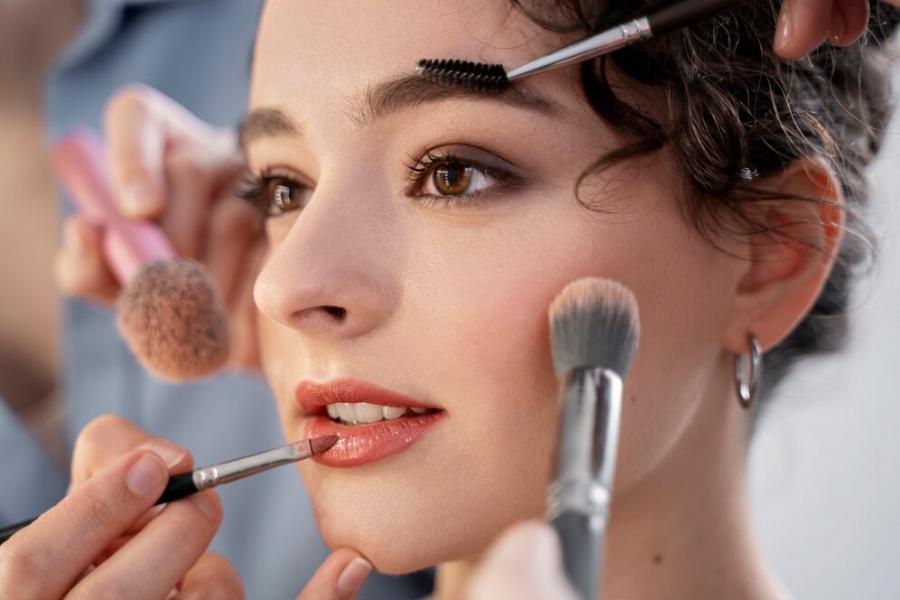Transition Your Makeup Routine from Summer to Winter

As the seasons change, so should your makeup routine. The transition from summer to winter brings colder temperatures, lower humidity, and drier skin, which means your makeup products and techniques need to adapt. A summer makeup routine often focuses on lightweight formulas, oil control, and sun protection, whereas a winter routine should prioritize hydration, nourishment, and protection against the harsh weather. Without adjusting your routine, you may find your makeup looking patchy, flaky, or dull. The key to a seamless transition is understanding how different environmental factors affect your skin and making the necessary changes to keep your skin looking healthy and radiant. Whether it’s swapping out your foundation for a more moisturizing formula or switching to a richer lip color, adapting your routine will ensure your makeup looks flawless throughout the colder months.
1. Adjusting Your Skincare Routine for Winter Makeup
A well-prepared skincare routine is the foundation of great makeup. As winter sets in, the dry and cold air can strip moisture from your skin, making it essential to switch to a more hydrating skincare routine before applying makeup. Neglecting your skincare during this time can lead to irritation, redness, and an overall dull complexion. The transition from a lightweight summer routine to a deeply nourishing winter routine is crucial for ensuring that your makeup applies smoothly and lasts longer throughout the day.
a. Switch to a Hydrating Cleanser
Summer cleansers are usually formulated to remove excess oil and sweat, which can be too harsh in winter. In colder months, opt for a gentle, hydrating cleanser that maintains your skin’s natural oils and prevents dryness. Look for ingredients such as aloe vera, chamomile, and ceramides, which help to soothe and replenish the skin barrier. A milk or oil-based cleanser can also work wonders in keeping your skin hydrated while removing makeup and impurities. Avoid using harsh foaming cleansers that strip the skin of its natural oils, as they can cause excessive dryness and irritation, making your makeup application uneven. Instead, choose a cleanser that provides deep nourishment while ensuring your skin remains supple and soft.
b. Use a Richer Moisturizer
Lightweight, gel-based moisturizers may not provide enough hydration in winter, as the skin loses moisture faster due to cold, dry air and indoor heating. Instead, switch to a richer, cream-based moisturizer containing ingredients like hyaluronic acid, ceramides, and glycerin to lock in moisture. Applying your moisturizer while your skin is slightly damp can further enhance hydration by sealing in water molecules. In addition, using an overnight hydrating mask can help replenish lost moisture and restore your skin’s natural balance. Moisturizing twice a day—morning and night—is crucial to keep your skin barrier strong and resilient against harsh weather conditions.
c. Apply a Hydrating Serum
Serums containing hyaluronic acid, vitamin E, and peptides can provide an extra boost of hydration, helping your skin retain moisture under makeup. Hyaluronic acid is particularly effective in attracting moisture from the air into your skin, preventing dehydration. If your skin is extremely dry, consider layering a facial oil over your serum and moisturizer to lock in hydration. Facial oils containing jojoba, rosehip, or argan oil work well to create a protective barrier against harsh winter winds. This added hydration step ensures that your makeup applies smoothly without settling into fine lines or dry patches.
d. Don’t Forget SPF
Many people skip sunscreen in winter, but UV rays are still present and can cause skin damage. Snow can reflect up to 80% of UV radiation, increasing the risk of sun damage. Use a broad-spectrum SPF 30 or higher to protect your skin from sun exposure year-round. Opt for a moisturizing sunscreen that contains added hydration benefits. Look for formulations that include nourishing ingredients such as shea butter, vitamin C, and antioxidants to provide additional protection against environmental stressors. Sunscreen should be the final step in your skincare routine before applying makeup, ensuring that your skin remains protected and radiant throughout the day.
2. Choosing the Right Winter Foundation
Your foundation should match the needs of your winter skin. In summer, matte and oil-free formulas help control shine, but in winter, you need a foundation that hydrates and provides a luminous finish. Foundation plays a crucial role in ensuring that your makeup looks seamless and natural, without emphasizing dry areas or fine lines caused by cold weather.
a. Opt for a Hydrating Foundation
Look for foundations with moisturizing properties, such as those containing hyaluronic acid or nourishing oils. Avoid matte or powder-based foundations that can accentuate dry patches. A dewy or satin-finish foundation can help maintain a natural glow despite the dry weather. If you prefer a bit more coverage, choose a medium to full-coverage foundation that still offers hydration without looking cakey. Applying foundation with a damp beauty sponge can further enhance its blendability and ensure a smooth finish.
b. Adjust Your Shade
Your summer tan fades in winter, which means your foundation shade may need to be lighter. Consider getting color-matched at a beauty store to ensure a seamless blend. You can also mix a drop of a lighter foundation into your summer shade to gradually transition as your skin tone changes. This approach helps avoid a stark contrast between your face and neck, ensuring a natural and balanced complexion.
c. Use a Primer for Extra Hydration
A hydrating primer can create a smooth canvas for makeup application, ensuring that your foundation applies evenly and lasts longer. Look for primers infused with glycerin or vitamin E to add an extra layer of moisture. If you have particularly dry skin, opt for a primer with a luminous finish to give your skin a healthy, radiant glow. A good primer not only hydrates but also helps your makeup stay fresh and flawless throughout the day.
3. Updating Your Face Makeup for Winter
a. Use a Cream-Based Blush and Bronzer
Powder formulas can make dry skin look patchy and dull. Instead, switch to cream-based blushes and bronzers that blend effortlessly and provide a dewy, hydrated finish. Cream formulas help maintain a fresh and youthful look without emphasizing dryness. They also add a natural flush of color to your cheeks, making your complexion appear healthy and vibrant. When applying cream blush, use your fingertips or a damp beauty sponge to ensure seamless blending.
b. Highlight Strategically
A subtle highlighter can bring warmth to your face, counteracting the dullness that often accompanies winter skin. Choose liquid or cream highlighters for a natural glow. Avoid chunky glitter-based highlighters, as they can enhance texture on dry skin. Instead, opt for finely milled highlighters with a pearl-like sheen to create a soft, diffused glow. Applying highlighter to the high points of your face, such as the cheekbones, bridge of the nose, and cupid’s bow, can enhance your features and give your skin a radiant appearance.
c. Set Lightly with a Hydrating Powder
If you use setting powder, opt for a finely milled, hydrating formula that prevents your makeup from looking cakey or dry. Apply only in areas prone to shine, such as the T-zone, to maintain a healthy-looking complexion. A lightweight, translucent setting powder with added skincare benefits, like vitamin E or jojoba oil, can help keep your makeup in place without compromising hydration. Instead of applying too much powder, use a light dusting technique to set your foundation while allowing your skin’s natural glow to shine through.
FAQS
How do I change my makeup for winter?
During winter, your skin tends to become drier due to cold air and indoor heating, so switching to more hydrating makeup products is essential. Swap your lightweight summer foundation for a hydrating or cream-based foundation that provides moisture and prevents flakiness. Use a luminous or hydrating primer to create a smooth base and prevent dryness. Opt for cream-based blushes and highlighters instead of powders, as they blend seamlessly into the skin and maintain a fresh, dewy look. Lip care is also important—use a hydrating lip balm before applying lipstick, and switch to creamy or satin-finish lipsticks instead of mattes to prevent chapping. Lastly, set your makeup with a hydrating setting spray rather than powder to maintain a natural, healthy glow throughout the day.
How do I prepare my skin for winter makeup?
Proper skin preparation is key to ensuring that your makeup applies smoothly and lasts longer in winter. Start with a gentle, hydrating cleanser to remove impurities without stripping your skin of moisture. Follow up with a hydrating serum containing ingredients like hyaluronic acid or glycerin to deeply nourish and plump the skin. A thick, rich moisturizer is crucial in winter to create a protective barrier against the harsh weather. Don’t skip sunscreen, even on cloudy days, as UV rays can still damage the skin. Exfoliate once or twice a week with a mild exfoliant to remove dead skin cells and prevent flaky patches, allowing for a smoother makeup application. Finally, use an eye cream to keep the delicate under-eye area hydrated and prevent concealer from creasing.
What type of makeup is best for winter?
The best winter makeup focuses on hydration and luminosity to counteract the dryness caused by cold weather. Choose a hydrating or dewy-finish foundation that provides moisture and a radiant glow. Cream or liquid blushes and bronzers blend effortlessly into the skin, keeping it from looking dry or cakey. Hydrating lipsticks or tinted balms are ideal, as they provide color while keeping the lips soft and nourished. Avoid heavy matte powders, which can settle into dry patches and make the skin appear dull. For eye makeup, opt for cream-based eyeshadows, as they blend easily without emphasizing dryness. A hydrating setting spray can help lock in moisture and keep your makeup looking fresh all day.
Is it OK to stop your skincare routine?
No, stopping your skincare routine, especially in winter, can have negative effects on your skin’s health. The cold air outside and indoor heating can strip moisture from your skin, making it dry, flaky, and more prone to irritation. Without a proper skincare routine, your skin barrier can weaken, leading to sensitivity, breakouts, and a dull complexion. Even if your routine is minimal, cleansing, moisturizing, and using sunscreen during the day are essential to maintaining healthy skin. At night, using hydrating serums and a nourishing night cream helps repair and replenish lost moisture while you sleep. Consistency is key to ensuring that your skin remains balanced and resilient throughout the winter months.
Is it better to have a skincare routine at night or morning?
Both morning and night skincare routines are important, as they serve different purposes. A morning routine focuses on protecting your skin from environmental damage. Start with a gentle cleanser, followed by a hydrating moisturizer and sunscreen to shield your skin from UV rays, pollution, and cold winds. A night routine, on the other hand, focuses on repairing and rejuvenating the skin while you sleep. This is the best time to use serums with active ingredients like retinol, peptides, or hyaluronic acid, which promote cell renewal and hydration. Using a richer night cream helps lock in moisture overnight, ensuring that your skin stays soft and plump by morning. For the best skin health, maintaining both routines consistently is ideal.
